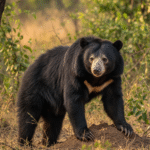
The Sri Lankan Leopard: Island’s Apex Predator
The Sri Lankan leopard (Panthera pardus kotiya) stands as the undisputed ruler of the island’s wilderness, a magnificent predator found nowhere else on Earth. This endemic subspecies holds a special distinction as the largest leopard in Asia, with males reaching up to 90 kg. Their striking golden coat adorned with dark rosettes provides perfect camouflage in Sri Lanka’s diverse landscapes, from the dry zone scrub jungles of Yala to the misty montane forests of Horton Plains. As the island’s only large wild feline, these solitary hunters have evolved to fill the apex predator role, exhibiting behaviors rarely seen in their African counterparts, including frequent daytime activity in protected areas.
Masters of Adaptation
What makes the Sri Lankan leopard truly remarkable is its adaptability across the island’s varied ecosystems. These territorial cats thrive in wet zone rainforests, intermediate zone woodlands, and the arid grasslands of the dry zone, demonstrating an ecological flexibility that has allowed them to persist across Sri Lanka. Their diet reflects this versatility, primarily hunting spotted deer, sambar, and wild boar, but opportunistically taking everything from toque macaques and giant squirrels to peafowl and even monitor lizards. Unlike leopards elsewhere that must compete with lions and tigers, Sri Lanka’s leopards reign supreme, allowing them to hunt more boldly and occupy the ecological niche of a true apex predator.
Life in the Wild
The life cycle of a Sri Lankan leopard is one of solitary independence punctuated by brief periods of family bonding. Females typically give birth to one to three cubs after a gestation period of about three months, raising them alone for 18 to 24 months in hidden dens among rocky crevices or dense thickets. Cubs begin sampling meat at six to eight weeks old while continuing to nurse, gradually developing the stealth and hunting skills that will define their adult lives. Sexual maturity arrives at around three years of age, after which these magnificent cats establish their own territories, with males controlling vast ranges that may overlap with several female territories.
A Species Under Threat
Despite their status as apex predators, Sri Lankan leopards face mounting pressures that have earned them an Endangered classification. Habitat loss from agricultural expansion and development continues to fragment their territories, while human-leopard conflict arises when these opportunistic hunters turn to livestock in areas where natural prey has declined. Although poaching is less severe than in some continental leopard populations, it remains a persistent threat alongside vehicle collisions in popular parks. Today, strongholds like Yala National Park, Wilpattu, and Kumana offer the best chances for survival, where conservation efforts work to balance the needs of both leopards and local communities.
Witnessing a Legend
For visitors to Sri Lanka, encountering a leopard in the wild remains one of nature’s most thrilling experiences. Yala National Park is renowned worldwide for having one of the highest leopard densities, offering remarkable viewing opportunities, while Wilpattu, Kumana, and Gal Oya provide equally authentic wilderness experiences. These sightings are more than just wildlife viewing—they’re glimpses into the survival of an ancient lineage that has called Sri Lanka home for millennia. Protecting these charismatic predators means preserving the intricate web of life that makes Sri Lanka’s biodiversity so extraordinary, ensuring that future generations can marvel at the island’s golden ghost of the forest.



Leave a comment: